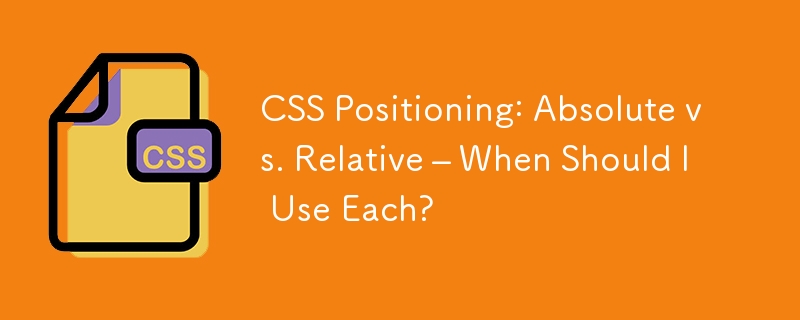CSS Positioning: Absolute vs. Relative – When Should I Use Each?

Positioning Elements with CSS: Absolute vs. Relative
When it comes to fine-tuning the layout of web pages, CSS positioning properties play a crucial role. Understanding the difference between absolute and relative positioning is essential for creating precise and visually appealing designs.
Absolute Positioning
position: absolute; removes an element from the normal document flow and places it at an exact location within the window or its parent container. The four properties used for positioning are top, right, bottom, and left. They act as offset properties, shifting the element from specific edges or points.
For instance, top: 10px; offsets the element 10pixels from the top of the window. Absolute positioning is often used for dropdowns, modals, and fixed elements that need to remain in a specific location.
Relative Positioning
position: relative; keeps an element within the normal flow of the document but offsets its position relative to its current location. This is useful for fine-tuning the placement of elements within a container without breaking the flow.
For example, a paragraph with position: relative; and left: 3em; would move 3em to the left of its current position, while still following the text after it. Relative positioning allows elements to overlap and adjust their positions dynamically based on other elements.
When to Use Each Positioning Type
- Absolute Positioning: Perfect for elements that need to appear in a fixed location, independent of the surrounding content. Used for dropdowns, modals, and elements that must stay within a specific area.
- Relative Positioning: Ideal for adjusting the position of elements within their container, while maintaining their position in the flow. Good for positioning buttons, images, and elements that need minor adjustments.
Additional Notes:
- Absolutely positioned elements have a default width equal to their content, while relatively positioned elements default to 100% width.
- Absolute positioning allows elements to overlap, while relative positioning does not (without using CSS tricks).
The above is the detailed content of CSS Positioning: Absolute vs. Relative – When Should I Use Each?. For more information, please follow other related articles on the PHP Chinese website!

Hot AI Tools

Undresser.AI Undress
AI-powered app for creating realistic nude photos

AI Clothes Remover
Online AI tool for removing clothes from photos.

Undress AI Tool
Undress images for free

Clothoff.io
AI clothes remover

Video Face Swap
Swap faces in any video effortlessly with our completely free AI face swap tool!

Hot Article

Hot Tools

Notepad++7.3.1
Easy-to-use and free code editor

SublimeText3 Chinese version
Chinese version, very easy to use

Zend Studio 13.0.1
Powerful PHP integrated development environment

Dreamweaver CS6
Visual web development tools

SublimeText3 Mac version
God-level code editing software (SublimeText3)

Hot Topics
 1664
1664
 14
14
 1422
1422
 52
52
 1316
1316
 25
25
 1268
1268
 29
29
 1242
1242
 24
24
 Google Fonts Variable Fonts
Apr 09, 2025 am 10:42 AM
Google Fonts Variable Fonts
Apr 09, 2025 am 10:42 AM
I see Google Fonts rolled out a new design (Tweet). Compared to the last big redesign, this feels much more iterative. I can barely tell the difference
 How to Create an Animated Countdown Timer With HTML, CSS and JavaScript
Apr 11, 2025 am 11:29 AM
How to Create an Animated Countdown Timer With HTML, CSS and JavaScript
Apr 11, 2025 am 11:29 AM
Have you ever needed a countdown timer on a project? For something like that, it might be natural to reach for a plugin, but it’s actually a lot more
 HTML Data Attributes Guide
Apr 11, 2025 am 11:50 AM
HTML Data Attributes Guide
Apr 11, 2025 am 11:50 AM
Everything you ever wanted to know about data attributes in HTML, CSS, and JavaScript.
 A Proof of Concept for Making Sass Faster
Apr 16, 2025 am 10:38 AM
A Proof of Concept for Making Sass Faster
Apr 16, 2025 am 10:38 AM
At the start of a new project, Sass compilation happens in the blink of an eye. This feels great, especially when it’s paired with Browsersync, which reloads
 How We Created a Static Site That Generates Tartan Patterns in SVG
Apr 09, 2025 am 11:29 AM
How We Created a Static Site That Generates Tartan Patterns in SVG
Apr 09, 2025 am 11:29 AM
Tartan is a patterned cloth that’s typically associated with Scotland, particularly their fashionable kilts. On tartanify.com, we gathered over 5,000 tartan
 How to Build Vue Components in a WordPress Theme
Apr 11, 2025 am 11:03 AM
How to Build Vue Components in a WordPress Theme
Apr 11, 2025 am 11:03 AM
The inline-template directive allows us to build rich Vue components as a progressive enhancement over existing WordPress markup.
 While You Weren't Looking, CSS Gradients Got Better
Apr 11, 2025 am 09:16 AM
While You Weren't Looking, CSS Gradients Got Better
Apr 11, 2025 am 09:16 AM
One thing that caught my eye on the list of features for Lea Verou's conic-gradient() polyfill was the last item:
 A Comparison of Static Form Providers
Apr 16, 2025 am 11:20 AM
A Comparison of Static Form Providers
Apr 16, 2025 am 11:20 AM
Let’s attempt to coin a term here: "Static Form Provider." You bring your HTML




